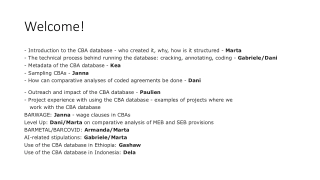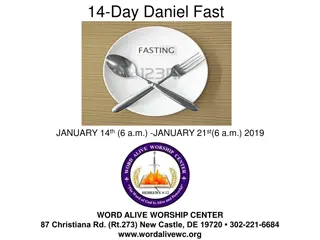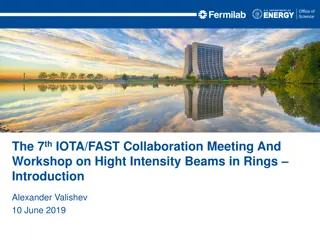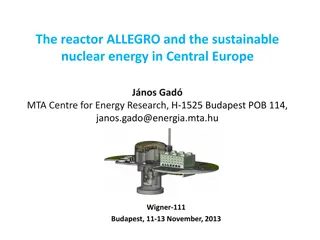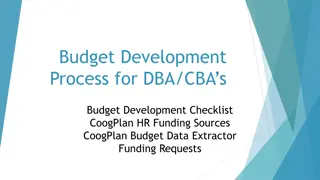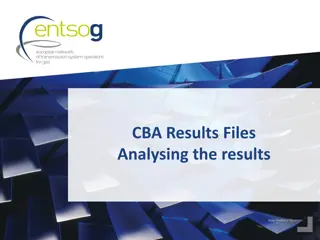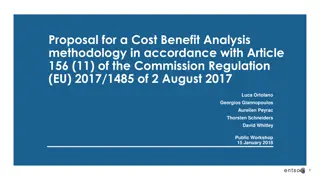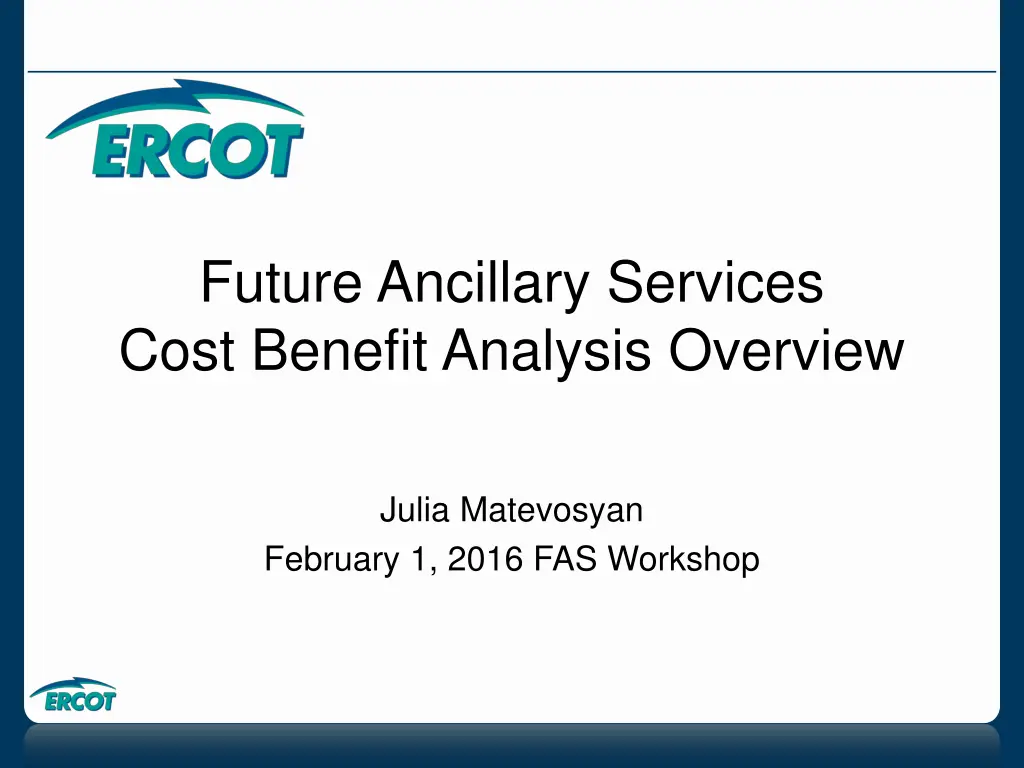
Future Ancillary Services Cost Benefit Analysis by Julia Matevosyan
Explore the detailed cost benefit analysis of future ancillary services, estimating significant benefits and a high benefit-cost ratio. The findings highlight potential savings and improvements in market design for reliability and flexibility.
Download Presentation

Please find below an Image/Link to download the presentation.
The content on the website is provided AS IS for your information and personal use only. It may not be sold, licensed, or shared on other websites without obtaining consent from the author. If you encounter any issues during the download, it is possible that the publisher has removed the file from their server.
You are allowed to download the files provided on this website for personal or commercial use, subject to the condition that they are used lawfully. All files are the property of their respective owners.
The content on the website is provided AS IS for your information and personal use only. It may not be sold, licensed, or shared on other websites without obtaining consent from the author.
E N D
Presentation Transcript
Future Ancillary Services Cost Benefit Analysis Overview Julia Matevosyan February 1, 2016 FAS Workshop
CBA Findings Estimated benefits of roughly $20 million per year. If discounting 10 years of benefits at 7.5%, their present value would be $137 million. The net present value accounting for ERCOT implementation costs would be over $120 million, and the benefit-cost ratio would be approximately 10. Brattle found that FAS is good market design, and will improve reliability and provide greater flexibility for meeting reliability needs as system conditions and resource capabilities evolve. 2
CBA Findings (Quantified Annual Benefits) Figure 5: Quantified Annual Benefits In 2016, PFR reduction provides high DA production cost savings (DA PCS) per MWh because it enables greater coal dispatch. 2024 has higher net load, so coal is more fully baseloaded. Real-time opportunity cost savings (RT OCS) analyzed through historical AS bids. Compare these annual benefits to ERCOT s one-time implementation cost of $12-15m. 3
CBA Findings CAS FAS Savings Comment Procure Less PFR by recognizing equivalency ratios and allowing more FFR (incl. FFR1) 2016 Avg MW 1,468 1,329 140 Allow > 50% FFR; no need for buffer. Increase FFR by 24 MW on average. 2024 Avg MW 1,453 1,325 129 Slightly less than 2016 due to higher net load & inertia. Increase FFR by 13 MW on average. 2024 Avg MW w/new tech 1,453 1,267 186 62 MW assumed new batteries reduce avg. PFR by 57 MW; small because residual avg. FFR opportunity (after load resources) is only 62 MW and highly variable Replace Non-Spinning Reserve with less CR and SR (products comparable because of common NSRS/CR/SR duties and supply base) 2016 Avg MW 1,931 1,175 756 FAS adapts requirements to system conditions; additionally CR is determined based on frequency obligations, and Non-Spinning Reserve is determined to meet deviations in net load. 2024 Avg MW 2,000 1,210 790 See above (note: assumptions about new tech do not affect CR) 4
RRS Assumptions in the CBA Same as in 2016 AS methodology: In the CBA RRS requirements are not flat 2800 MW but based on expected system inertia. Differently from 2016 AS methodology: In the CBA, RRS is determined for every hour in the CBA, not as six 4-hourly blocks for a month. >> Estimated savings reflect 2016 AS Methodology for determining RRS quantities. (Approved by BOD December 2015) 5
NSRS Assumptions in the CBA Differently from 2016 AS methodology: In the original CBA runs NSRS amounts were determined as per 2015 AS methodology. However, Brattle was able to estimate savings in each scenario with NSRS requirements calculated based on 2016 AS methodology and reduced IFRO. Table ES-1: Summary of Annual Benefits Case 2016 2024* Annual Benefits Annual Benefits with Alternative Assumptions** $21.5 $22.0 $19.4 $14.5 *2024 benefits include the effects of new technology enabled by FAS **Alternative Assumptions include updated NSRS and Minimum PFR requirements 6
Benefits not quantified in the CBA The CBA was executed assuming both CAS and FAS quantities were determined in the DA. Any approach in which quantities for CAS are determined in advance of DA will include a buffer and the savings from FAS would be higher. Reliability benefits are not quantified in the CBA FAS removes uncertainty of load resource participation FFR1 supports frequency at 59.8 Hz instead of 59.7 Hz. Most events would not activate FFR2, so FFR2 will have higher probability of being available for (the next) worst event. If deployed, FFR1 can reset in 10 minutes and be ready for the next event. In FAS, the amount of PFR that a resource can carry is based on its performance (instead of 20% HSL under CAS). A single resource will be limited to carry up to 25% of the system wide regulation requirement in FAS, leading to a more distributed and reliable response than CAS. 7
Concerns Raised and Action Items The gas price forecast used in the analysis for 2016 seems too high. ACTION: ERCOT is planning to run 2016 with a more recent gas price forecast. Plan to have results available for March 2016 discussion. CBA did not take into consideration the implementation costs for Stakeholders. ACTION: ERCOT requests that Stakeholders provide estimates of the cost to implement changes required for NPRR 667 for March 2016 discussion. 8
Appendix: RRS, PFR/FFR Quantities Quantities are based on hourly system inertia from 2016, 2024 Current Trends and 2024 Stringent Environmental Scenarios simulation in Plexos, 8760 values Hourly system inertia is matched to one of 13 cases and corresponding RRS, PFR/FFR quantities and FFR to PFR equivalency ratio are selected for each hour. Minimum RRS from generation or minimum PFR is based on NERC BAL-003 IFRO Case 0 Case1 Case2 Case3 Case4 Case5 Case6 Case7 Case8 Case9 Case10 Case11 Case12 100 120 136 152 177 202 230 256 278 297 316 332 350 Inertia, GWs 2.35 2.2 2 1.5 1.4 1.3 1.25 1.13 1.08 1 1 1 1 Eq. Ratio PFR 7358 5200 4700 3750 3370 3100 3040 2640 2640 2240 2280 2140 2140 Requirement (no FFR), MW Min PFR Requirement, MW 1240 1240 1240 1240 1240 1240 1240 1240 1240 1240 1240 1240 1240 9

